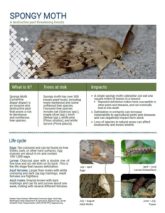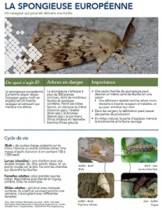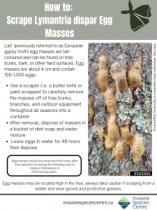Spongy Moth
Formerly known as European Gypsy Moth
French common name: Spongieuse
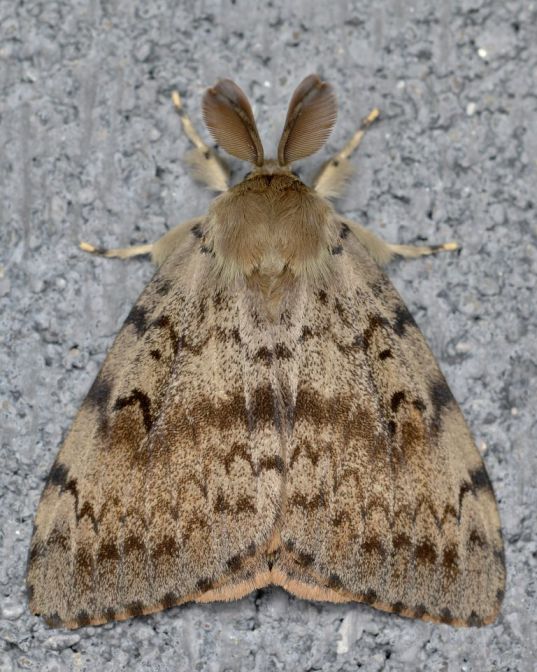
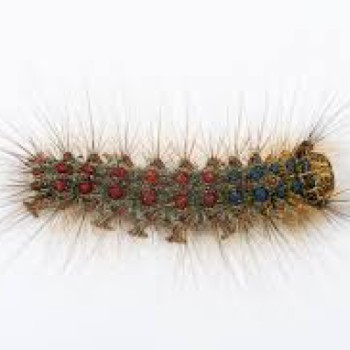
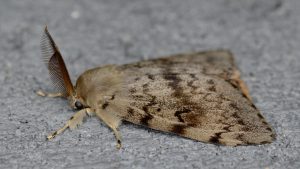
In March 2022, Entomological Societies of Canada and America adopted the name spongy moth as the new common name for the moth species Lymantria dispar.
The Invasive Species Centre will be transitioning our materials from “Ldd moth” and “gypsy moth” to spongy moth. We will be sharing information about this change at events and in our resources.
Order: Lepidoptera
Family: Lymantriidae
The spongy moth is native to Europe and is currently established in northeastern United States and eastern Canada (portions of Ontario, Quebec, New Brunswick, Prince Edward Island and Nova Scotia). The larvae (caterpillars) feed on crown foliage of a wide range of hardwood and some softwood trees, which makes it a defoliating forest pest of concern.
Quick tips:
- Examine your outdoor household items on a regular basis during the spring and summer months. Items such as furniture, camping equipment, trailers, and firewood can harbour egg masses.
- If caterpillars or larvae are found, wear gloves when handling the insects, as their hairs can cause skin irritation on humans.
- If eggs are detected, scrape the fuzzy, tan-coloured masses off of the equipment they are affixed to, and destroy them immediately by crushing the eggs or by submerging the eggs into a bucket filled with water and household bleach or soap for at least two days. After two days, discard the solution and egg mixture.
- Never move firewood.
Physical Description
Eggs: Tanned yellow, covered with fuzz and found as “egg masses” in the protected areas of trees and outdoor items such as, vehicles, garbage cans, furniture and children’s toys.
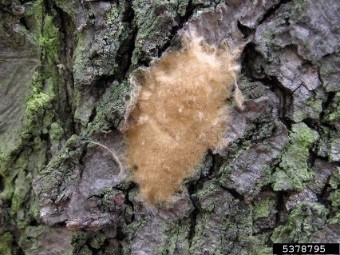
Photo: Milan Zubrik, Forest Research Institute – Slovakia, Bugwood.org
Larvae: Up to 6 cm in length, covered with hairs. The caterpillar is characterized by five pairs of blue dots and six pairs of red dots that run down its back.
Pupal stage: Larval caterpillars transition to become winged moths. During this stage the skin of the larva hardens and metamorphosis takes place inside the dark brown shell.
Adults: Winged moths. Males are brown in colour and have feathery antennae. Females are beige in colour and cannot fly. The adults cannot feed due to the lack of a mouthpart, leaving them only about two weeks to mate and produce eggs before they die.
Life Cycle
The spongy moth female lays between 500 to 1,000 eggs in tree bark crevices. The eggs are covered with hairs from the female’s abdomen. The eggs hatch in spring (April), and the emerging larvae from the eggs climb up the trees to feed on leaves. The majority of the feeding occurs during the night. The larval stage lasts for approximately 40 days. At the end of this stage, the larvae seek safe shelter to pupate. In early summer (June-July), the larvae enter a transitional stage for 10 to 14 days in which the larvae transform into adults. Adults have less than two weeks to mate and reproduce before they die.
The spongy moth has over 300 known host plant species, and about 150 of them are considered favoured hosts. The favourability of a forest species influences the severity and longevity of an infestation. A caterpillar feeds primarily on hardwood trees, and may feed on softwood trees.
Some favoured host tree species include:
- Oak (Quercus spp.)
- Maple (Acer spp.)
- Birch (Betula)
- Alder (Alanus spp.)
- Hawthorne (Crataegus spp.)
Signs and symptoms of spongy moth include:
- Egg masses found on tree bark and outdoor objects.
- Leaves with holes or completely defoliated trees. Defoliation will result in the dieback of twigs and branches, and will make affected trees vulnerable to disease and other pests as they spend their energy reserves to regrow leaves in mid-summer.
The spongy moth is native to Europe, Asia, and north Africa. Introduced to North America 130 years ago, and has since been detected in states in northeastern U.S.A. and in portions of the eastern Canadian provinces of Ontario, Quebec, New Brunswick, Prince Edward Island, and Nova Scotia.
The long-distance spread has been largely attributed to the movement of firewood, as well as outdoor recreational and household articles; public awareness could significantly reduce and limit the spread to new areas.
To see the current EDDMapS distribution map, click on the link below.
In Canada, the spongy moth is federally regulated by the Canadian Food Inspection Agency. The CFIA outlines the following directives:
D-01-12: Phytosanitary Requirements for the Importation and Domestic Movement of Firewood
D-95-11: Export requirements for cut Christmas trees to Mexico
D-95-08: General Import Requirements for Fresh Temperate Fruits from the World
Spongy moths are most destructive in their larval stage – as caterpillars – stripping away foliage from a broad variety of trees. Repeated defoliation stresses trees and can lead to mortality, especially in urban or drought-stricken areas, and can weaken tree regeneration due to impacted seed production and root sprouting.
An estimated 595 million hectares of North America are considered climatically suitable for the establishment of Spongy moth populations (Gray, 2004). The efforts to control and manage the pathways of spongy moths is crucial to mitigate the possible economic, ecological, and social impacts on potential areas of spread.
Economic impacts
An infestation can defoliate a broad range of tree species, impacting the aesthetics of a forest. In urban areas, this can impact property values and impose costs for tree removal and replacement. In addition, tree defoliation can negatively affect tourism.
The spongy moth was estimated to have caused the loss of roughly $120 million in residential property value per annum in the US from 1998 to 2007, and $298 million in US federal expenditure targeted at spongy moth for the same ten-year period (Aukema, 2011). The amount for the US federal expenditure included suppression, research, and ‘slow the spread’ programs.
Ecological impacts
Invasions disrupt the ecological services provided by trees, impact wildlife habitat and reduce food production for dependent species. The dieback of twigs and branches due to defoliation causes canopy thinning, thereby weakening trees.
Invasions are capable of affecting forest tree composition. It is a concern that spongy moth might affect the oak regeneration success in eastern North America, given that oak species are one of the preferred.
Social impacts
Direct skin contact with spongy moth caterpillar hairs could result in a rash and/or skin irritation. On a recreational level, defoliated trees and thinned canopies degrade the aesthetic value of trees.
Spongy moth management strategies are either intended for immediate control of populations during outbreaks where it is established to minimize the impact, or long-term strategy methods intended to prevent the introduction and spread.
In areas where spongy moth is established, integrative pest management techniques such as burlap banding and pheromone traps are used to keep populations suppressed and at a manageable level. Detection traps using pheromone lures are often used as a means to define the extent of the spread over an area or where it may still exist after a treatment has taken place. Pheromone traps are also used in combination with other management methods for suppression and eradication of spongy moth populations. In addition, education is important because the cooperation of the public can play an important role in slowing or preventing the spread of spongy moth to new areas. Finally, pathway regulation and phytosanitary risk mitigation measures such as establishing quarantines can help slow the spread.
Detect
Detection surveys such as pheromone-based trapping can provide information about the status of spongy moths in Canada and the U.S. These surveys determine whether the species is present, absent, in restricted distribution, widespread, or eradicated in a given area. This data is available on the CFIA website.
Respond & Control
Mechanical
Small scale spongy moth populations can be managed mechanically through:
- Scraping and destroying egg masses.
- Applying burlap and sticky barrier bands to trunks of potential host trees.
- Both techniques are used to keep the spongy moth population suppressed and at a manageable level.
Chemical
In Canada, Btk (Bacillus thuringiensis) bacterium spray treatment has been used to control the spongy moth where established on public trees prior to egg hatch, as it is only poisonous to the larvae.
Biological
Entomophaga maimaigi is a target species specific fungus that infects populations in their native range in Japan. It had been introduced in the United States and had caused mass mortality for populations where established. Infections are more likely to spread in a wet spring, than in any other season.
Nucleopolyhedrosis virus (NPV) is a virus that only affects spongy moth. NPV occurs naturally but only in large populations. The virus severely damages the internal organs of caterpillars, thereby killing them. This was used in Canada to develop the biological pesticide, Dispavirus.
Spongy Moth Resources
Best Management Practices
Research
Climate suitability and management of the gypsy moth invasion into Canada
Superior where the climate is suitable for the completion of its univoltine life cycle. The
spread of the gypsy moth to the north and west in Canada has so far been prevented by …
Natural enemies and environmental factors affecting the population dynamics of the gypsy moth
may reach outbreak levels that pose considerable economic and environmental impacts to
forests in E urope, A sia, A frica and N orth America. Compared with the situation in its native …
Gypsy moth invasion in North America: a simulation study of the spatial pattern and the rate of spread
northeastern US has led to widespread forest defoliation, wildlife disruption and even a
change in biogeochemical conditions over the area of 10 6 km 2. Spread of gypsy moth has …
Current Research and Knowledge Gaps
Lorem ipsum dolor sit amet, consectetur adipiscing elit. Ut elit tellus, luctus nec ullamcorper mattis, pulvinar dapibus leo.
Further Reading
The Invasive Species Centre aims to connect stakeholders. The following information below link to resources that have been created by external organizations.

